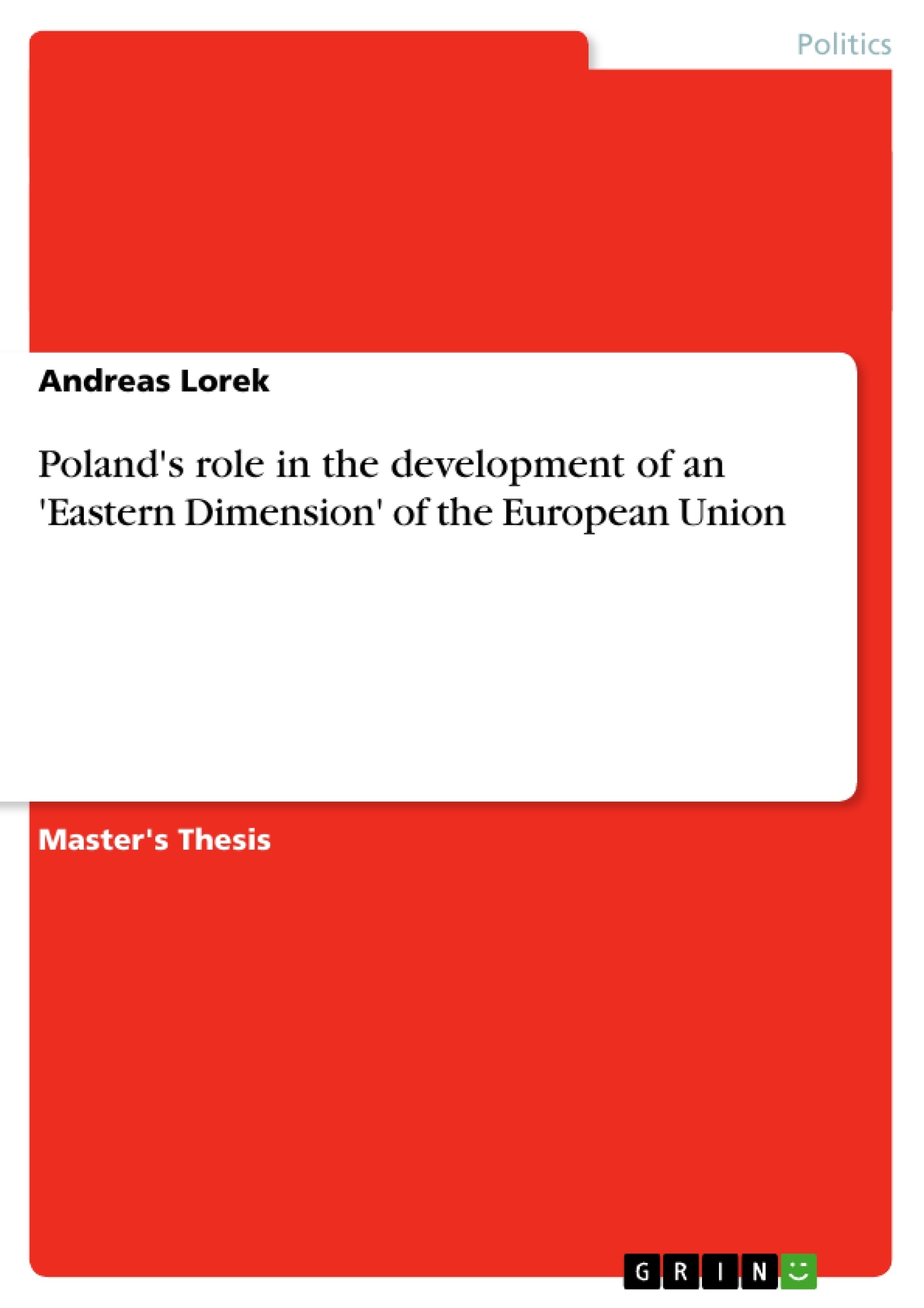Im Zuge des Beitrittsprozesses zur EU entwickelte Polen sein Konzept der ‚Eastern Dimension’. Der ehemalige polnische Außenminister Bronisław Geremek erklärte bei der Eröffnung der Beitrittsverhandlungen im Jahre 1998 zum ersten Mal den Wunsch einer gemeinsamen europäischen Ostpolitik. Bisher wurde dieser Vorschlag Polens nicht (bzw. nur in Bruchstücken) umgesetzt, alle polnischen Regierungen bis heute benennen die Implementierung einer ‚Eastern Dimension’ als Ziel der eigenen Außenpolitik.
Auch die EU erkannte die Notwendigkeit, eine gemeinsame Politik für die neuen Nachbarn zu entwickeln. Der Rat der Europäischen Union beratschlagte im April 2002 zum ersten Mal über ‚Wider Europe’ und die Beziehungen der erweiterten EU zu den östlichen Nachbarn. In den folgenden Ratssitzungen wurde das Thema vertieft, allerdings wurde spätestens beim Europäischen Rat in Kopenhagen im Dezember 2002 klar, dass eine gemeinsame Europäische Nachbarschaftspolitk (ENP) für alle Nachbarländer der EU entwickelt werden sollte, die neue Politik sollte neben den osteuropäischen Staaten also auch die Länder des Mittelmeerraumes und zusätzlich die Kaukasus-Staaten umfassen.
In meiner Master-Arbeit mit dem Titel „Poland’s role in the development of an ‚Eastern Dimension’ of the European Union“ bin ich der Frage nachgegangen, wieso der polnische Vorschlag nicht umgesetzt wurde. Welche Interessensunterschiede oder Umstände führten dazu, dass keine neue Regionalpolitik für die östlichen Anrainerstaaten definiert wurde? Durch einen Vergleich der zentralen Dokumente der ‚Eastern Dimension’ und der ENP konnte ich die wesentlichen Unterschiede dieser beiden Politiken analysieren. Wichtig war natürlich auch der derzeitige Stand der Beziehungen zwischen der EU und den östlichen Nachbarn. Die Teilnahme der Ukraine und Belarus in der ENP ist vorgesehen, bisher ist allerdings erst die Ukraine in die Gemeinschaftspolitik integriert. Die Teilnahme von Belarus in der ENP kann erst erfolgen, wenn demokratische Reformen durchgeführt werden. Die bilateralen Beziehungen zwischen Russland und der EU stellen sich als schwierig dar, Russland lehnt es ab im Rahmen der ENP mit der EU zu kooperieren.
Inhaltsverzeichnis (Table of Contents)
- List of Abbreviations
- List of figures
- List of charts
- Appendix
- Abstract
- 1. Introduction
- 1.1. The 'Eastern Dimension' of the European Union
- 1.2. Problem
- 1.3. Structure
- 2. Explaining Poland's role with theoretical concepts
- 2.1. Intergovernmentalism
- 2.2. Supranationalism
- 2.3. Intergovernmentalism vs. Supranationalism
- 3. Poland's foreign policy after 1989
- 3.1. Principles of Poland's foreign policy
- 3.2. Poland's Eastern Policy
- 3.3. Eastern policy and regional cooperations
- 4. Poland and its Eastern neighbours
- 4.1. Ukraine
- 4.1.1. 1991 to 1994: Polite declarations and mutual commitments
- 4.1.2. 1994 to 1998: Poland's integration in the Western structures
- 4.1.3. 1998 to 2004: Poland's way in the EU
- 4.1.4. From 2004: The 'Orange Revolution' and beyond
- 4.2. Belarus
- 4.2.1. 1991 to 1994: Belarus' decline under independence
- 4.2.2. 1994 to 1996: The begin of Aleksander Lukashenko's presidency
- 4.2.3. 1996 to 2001: International isolation
- 4.2.4. From 2001: Belarus as the last dictatorship in Europe
- 4.3. Russia
- 4.3.1. 1989 to 1994: Poland's Russia-centered policy
- 4.3.2. 1994 to 1999: Russian vs. Polish interests
- 4.3.3. 1999 to 2004: Slight normalisation of the relations
- 4.3.4. From 2004: Poland as a member of the EU
- 4.1. Ukraine
- 5. Poland and European foreign policy
- 5.1. From an Eastern policy to a 'Wider Europe'
- 5.1.1. Poland's contribution to the European Neighbourhood Policy
- 5.1.2. 'Eastern Dimension' vs. ENP: similarities and differences
- 5.1.3. The ENP in practice
- 5.1.4. Countries included in the ENP
- 5.1.4.1. Ukraine
- 5.1.4.2. Belarus
- 5.2. The EU and Russia
- 5.2.1. Russia and the ENP
- 5.2.2. Poland, Russia and the EU
- 5.3. 'Eastern Dimension', ENP and theoretical concepts
- 5.1. From an Eastern policy to a 'Wider Europe'
- 6. Conclusion
- Literature and Documents
Zielsetzung und Themenschwerpunkte (Objectives and Key Themes)
This Master's thesis aims to analyze Poland's role in the development of an "Eastern Dimension" of the European Union. The work examines the historical context, key actors, and theoretical frameworks influencing Poland's approach to its Eastern neighbors.
- Poland's foreign policy after 1989 and its focus on the East
- The impact of EU enlargement on Poland's Eastern policy
- The relationship between the European Neighborhood Policy (ENP) and the "Eastern Dimension"
- The complexities of Poland's relations with its Eastern neighbors, specifically Ukraine, Belarus, and Russia
- The theoretical frameworks of intergovernmentalism and supranationalism in explaining Poland's role in shaping the EU's Eastern dimension
Zusammenfassung der Kapitel (Chapter Summaries)
The thesis begins by introducing the concept of the "Eastern Dimension" and outlining the research problem. Chapter 2 explores theoretical frameworks, such as intergovernmentalism and supranationalism, to analyze Poland's role in shaping EU policy towards the East. Chapter 3 provides an overview of Poland's foreign policy after 1989, including its Eastern policy and regional cooperation initiatives. Chapter 4 examines Poland's relations with its Eastern neighbors, focusing on Ukraine, Belarus, and Russia, and their respective relationships with the EU. The thesis concludes by examining the broader context of the EU's Eastern policy, including the development of the ENP and its implications for Poland's role.
Schlüsselwörter (Keywords)
The thesis delves into the complex relationship between Poland and its Eastern neighbors, focusing on the development of the EU's Eastern Dimension. It explores the interplay of theoretical frameworks, foreign policy strategies, regional cooperations, and historical contexts. Key terms include the "Eastern Dimension," the European Neighborhood Policy (ENP), intergovernmentalism, supranationalism, Ukraine, Belarus, Russia, and Poland's foreign policy after 1989.
- Arbeit zitieren
- Andreas Lorek (Autor:in), 2006, Poland's role in the development of an 'Eastern Dimension' of the European Union, München, GRIN Verlag, https://www.grin.com/document/65894



